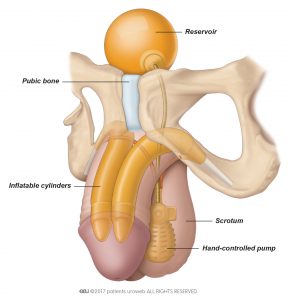Table of Contents
What is a penile implant?
A penile implant, also called a penile prosthesis, is a medical device which is surgically implanted into the erection chambers of the penis in case of severe ED.
When should I consider penile implant surgery?
A penile implant is an option if you have tried PDE5Is and intracavernous injections and both had little effect on ED. It may also be recommended if you cannot use PDE5Is or the drugs in the injections. If you have tried PDE5Is and injections, but are unhappy with the results and you want a permanent solution, a penile implant may be an option for you.
How does a penile implant work?
There are two types of penile implants: semirigid, noninflatable implants and inflatable implants.
Semi-rigid implants consist of two bendable rods that are implanted in the erection chambers of the penis. They can be bent into position during sexual activity. With this type of implant, the penis is always semi-rigid, which may be difficult to conceal.
Inflatable penile implants are devices filled with fluid which consist of two inflatable cylinders placed in the erection chambers of the penis, a hand-controlled pump placed in the scrotum, and a reservoir which stores fluid when the penis not erect. The device is inflated by squeezing the pump several times to move the fluid from the reservoir to the cylinders. Afterwards, the pump is also used to move the fluid back to the reservoir (Fig. 1).
You need surgery for both types of implants. Both types of implants are placed completely inside the body. Inflatable implants are used more often because they result in a more natural situation. In complicated cases, semi-rigid implants may be more suitable. Discuss the choice between the two implants with your urologist.
The procedure
For penile implant surgery, you will receive either general or spinal anaesthesia. You will also get a urinary catheter, which can be removed the day after surgery. Once you are under anaesthesia, the doctor will make a small incision either just above the penis or between the penis and the scrotum. The incision exposes the erectile chambers, and the surgeon measures them to place a penile implant of the correct length.
Once the cylinders are in place, the reservoir is placed behind the abdominal wall, and the pump is placed in the scrotum between the testicles to conceal the pump.
Finally, all elements of the implant are connected and the incision is sutured. The wounds are cleaned and a compressive bandage is applied. Most surgeons choose to leave the penile implant inflated for one day. Some surgeons prefer to leave a drain which is then usually removed one day after the procedure.
How to prepare
Your doctor will advise you in detail about how to prepare for the procedure. You must not eat, drink, or smoke for 6 hours before surgery to prepare for the anaesthesia. If you are taking any prescribed medication, discuss it with your doctor. You may need to stop taking it several days before surgery.
After the procedure
How long will it take me to get back to my daily activities?
Usually, you can leave the hospital the day after surgery, when the compressive bandage has been removed and the implant has been deflated by your doctor. You may experience pain or soreness and swelling of the penis and scrotum in the first few days and up to several weeks after surgery. This is normal and can be treated with analgesics and cold packs. In the first 2-3 days after surgery, there may be a small amount of discharge from the incision. There is no need to treat this because it usually stops on its own.
For 4-6 weeks after the surgery:
- Do not lift anything heavier than 5 kilograms
- Do not do any heavy exercise and avoid bike riding
- Do not take thermal baths or go to the sauna
- Discuss any prescribed medication with your doctor
Your doctor will schedule an appointment to inflate the implant for the first time. This is done once the swelling and soreness have gone, about 4-6 weeks after the procedure. After the appointment, you may start having sexual activity.
You should notify your urologist if:
- The swelling is severe or not improving
- You have discharge of a large amount of fluid each day
- The pain gets worse or does not improve
- You notice increased redness or tenderness around the incision site
- You have a fever


